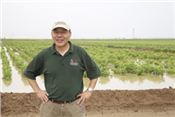|
Flood-Tolerant Soybeans

Dr. Pengyin Chen, soybean breeder with the University of Arkansas
Division of Agriculture, has been directing flood tolerant soybean
research and eventually trying to move those genes into high
yielding varieties.
Photo by John LaRose, Jr.
Research Seeks Flood-Tolerant Traits To Breed Into Soybean Lines
BETTY VALLE GEGG-NAEGER
MidAmerica Farmer Grower
STUTTGART, ARK.
Flood tolerant research is underway under the direction of Dr. Pengyin Chen, soybean breeder with the University of Arkansas Division of Agriculture.
“You’re seeing in the background flood tolerant research plots,” he said. ”This is a new research effort focusing on identifying sources of flooding tolerance and genes that are controlling the trait; and then eventually we’ll try to move these genes into high yielding varieties. Flooding imposes stress onto the soybean plants, in a situation where you have a heavy rain or you have irrigation and then you get a rain, so the flood may stay there for some time; or in some scenarios, it may be where the soil stays wet so it poses stress to the root system.”
There are some genetic differences with flooded soybeans at different stages, three days, six days, nine days or 12 days. Six days is probably the most favorable to tell the genetic difference.
“A lot of soybeans will die and some will survive at six days, so we’ll find those survivors and look further for the genetics on them, then develop molecular markers to help our selection for the tolerance; and eventually, by cross breeding, we can move the tolerance to the higher yielding varieties,” Chen explained.
“The trait is very challenging to work on initially, but once we find the source of tolerance and the genetic control, we’ll identify the markers that will help us facilitate the breeding process to get the varieties released,” he added. “Then those products will be marketed for commercialization. We are very confident it is going to help our farmers have a better crop and a stable yield.”
This research was initiated about three or four years ago just as a side project. Now support is coming in from the United Soybean Board and Arkansas Soybean Promotion Board, so this effort has expanded and now there’s collaboration with Missouri, Georgia, and a North Carolina group. However, the main effort is in Arkansas, because the perfect set up exists here, which includes zero grade fields and heavy soil that holds water better.
“So we can test the genetic difference here and that helps us select the best soybeans,” he said.
In the years of this trial, researchers have seen very few commercial varieties that are tolerant, although they have screened about 250 commercial varieties each year and only a handful have shown low levels of tolerance. They also screened a diverse set of their breeding material and found some lines that are better than others.
“We have identified those as a source of flooding tolerance and are in the process of incorporating that flooding tolerance into high yielding varieties now,” Chen reported.
“The current varieties we have now that we find have a high tolerance are an old variety called RA 452, in which we have seen consistent performance in flooding; and our own release, Osage, has been moderately tolerant to flooding, so we do have some recommendations.
“It appears Osage was selected at this location and released in our program, and I think that’s probably the reason for that,” he added. “So we’re paying close attention to the genetics and we’re working diligently specifically on selections and testing to find the genetics and value of the stress tolerance.”
As Chen spoke, a field in the background had been flooded six days.
“We set up the first block at three days, then one at six days, and the water will stay for each designated duration then we’ll pull the flood out,” he said. “Then in the next plot there is a nine-day flooding and beyond that a 12-day plot. So, generally speaking, three days will do minimal damage, and the majority of the lines will survive from that strain; the six-day will probably have a 50/50 chance, some of the lines will survive; at nine days probably 20 percent or 30 percent will survive, and 12 days will probably show 90-plus percent dead. Then we will see the different levels of tolerance, and we’ll use the highest level tolerance in our breeding program.”
Chen added that his group is doing two different stages, the fifth leaf stage and first bloom stage, so the trial is very limited as to when the flooding occurs.
“However, we want to start from there, the most sensitive stage, so we can see the difference,” he said. “Later, we’ll work with other researchers and relate this tolerance to early stages which is often seen in the farm situation right after planting. Often, a heavy rain at planting occurs, and farmers need to know if the crop is going to survive, and whether or not there will be a good stand. That’s what we are going to do in the future.” ∆
|
|